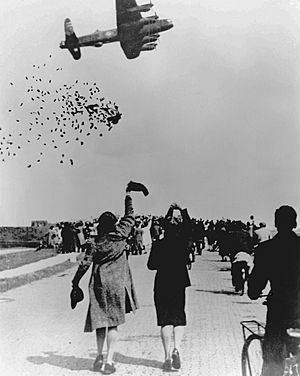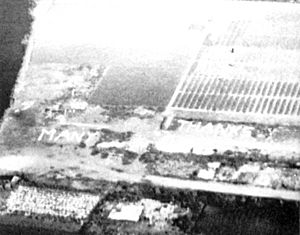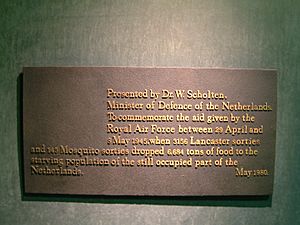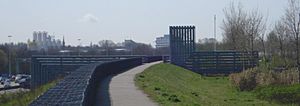Operations Manna and Chowhound facts for kids

Operation Manna and Operation Chowhound were special missions to drop food from planes. They happened during the last days of World War II in Europe. These missions helped people in the Netherlands who were suffering from a terrible famine.
Operation Manna (April 29 – May 7, 1945) was carried out by British RAF planes. Pilots from Australia, Canada, New Zealand, and Poland also helped. They dropped 7,000 tons of food. Operation Chowhound (May 1–8, 1945) was done by the United States Army Air Forces. They dropped 4,000 tons.
In total, over 11,000 tons of food were dropped in about a week and a half. The German forces, who still controlled parts of the Netherlands, allowed these food drops to happen. This helped feed Dutch civilians who were in danger of starving.
After these air drops, a ground mission called Operation Faust started. On May 2, 200 Allied trucks began delivering food to the city of Rhenen, which was behind German lines.
Contents
Why the Food Drops Were Needed
By early 1945, life was very hard for over three million Dutch people still under German control. Food was scarce, and many were starving.
Prince Bernhard of the Netherlands asked Dwight D. Eisenhower, the top Allied commander, for help. Eisenhower didn't have the power to make a truce with the Germans on his own. But with permission from British Prime Minister Winston Churchill and U.S. President Franklin D. Roosevelt, Eisenhower told Air Commodore Andrew Geddes to start planning. The plan was approved on April 23.
Allied representatives then talked with the German leader, Reichskommissar Arthur Seyss-Inquart, and his officers. They agreed that the planes dropping food would not be shot at if they stayed within certain flight paths.
Operation Manna: The British Effort

The British part of the operation started first. It was named "Manna" after the special food that appeared for the Israelites in the Bible story. The Royal Air Force did most of the planning.
On April 29, 1945, two RAF Avro Lancaster planes were chosen for a test flight. One was nicknamed Bad Penny. This plane, with its crew of seven young men (five from Canada), took off in bad weather. The Germans had not yet agreed to stop shooting, but the crew flew very low, sometimes only 50 feet off the ground, past German guns. Bad Penny successfully dropped its food and returned safely. The Germans officially agreed to the ceasefire the next day.

After the test, Operation Manna began in full. British planes, mostly Lancaster bombers, flew 3,156 missions. Smaller Mosquitoes flew 145 missions.
Normally, bombers dropped bombs from very high up (about 6,000 meters). But for this mission, they flew much lower, around 150 meters (or even 120 meters). This was because the food packages didn't have parachutes. The planes dropped food in places like Katwijk, The Hague, Rotterdam, and Gouda. In total, British planes delivered 6,680 tons of food.
John Funnell, a navigator on one of the planes, said they dropped canned food, dried food, and chocolate. He remembered seeing people on the ground waving flags and signs saying "Thank you for coming boys." He also said that even though there was no official truce at first, they flew low to avoid anti-aircraft guns.
The plan was for people to collect and share the food. However, some people who were very hungry ate too much right away. This made them sick, and some even died. This is a condition called refeeding syndrome, which can happen when starved bodies get rich food too quickly. Also, sometimes it took up to ten days for the food to be given out, so some people got it only after the war ended. Still, these food drops saved many lives and gave people hope that the war would soon be over.
Operation Chowhound: The American Effort
On the American side, ten groups of United States Army Air Forces planes flew 2,268 missions starting May 1. They delivered 4,000 tons of food. About 400 B-17 Flying Fortress bombers dropped 800 tons of K-rations (military food packages) over Amsterdam Schiphol Airport between May 1 and 3.
One B-17 crew, from a plane called Stork Club, even faced fire from German anti-aircraft guns. They were recognized for their bravery, even though they were on a humanitarian mission without their own guns.
Planes Lost
Sadly, three planes were lost during these operations. Two crashed into each other, and one had an engine fire. Some planes that returned also had bullet holes. These were likely from individual German soldiers who didn't know about the ceasefire or chose to ignore it.
Common Misunderstandings
Before the air drops, there was a different relief effort. White "Swedish bread" made from flour from Sweden was shipped in and baked locally. Some people mistakenly think this bread was dropped from planes, but it was delivered by ship.
Also, no food was dropped using parachutes during Operations Manna and Chowhound, even though this is often incorrectly claimed.
Honoring the Missions
In May 1980, the Minister of Defence of the Netherlands presented a special plaque to the Royal Air Force. This plaque thanked them for their help with Operation Manna. It is now displayed in the Royal Air Force Museum in Hendon, England.
On April 28, 2007, British Air Commodore Andrew James Wray Geddes was honored. A hiking trail in Rotterdam, called the Air Commodore Geddespath, was named after him. This path goes past a monument for Operation Manna/Chowhound. His son and grandson helped unveil the plaque for the path.



